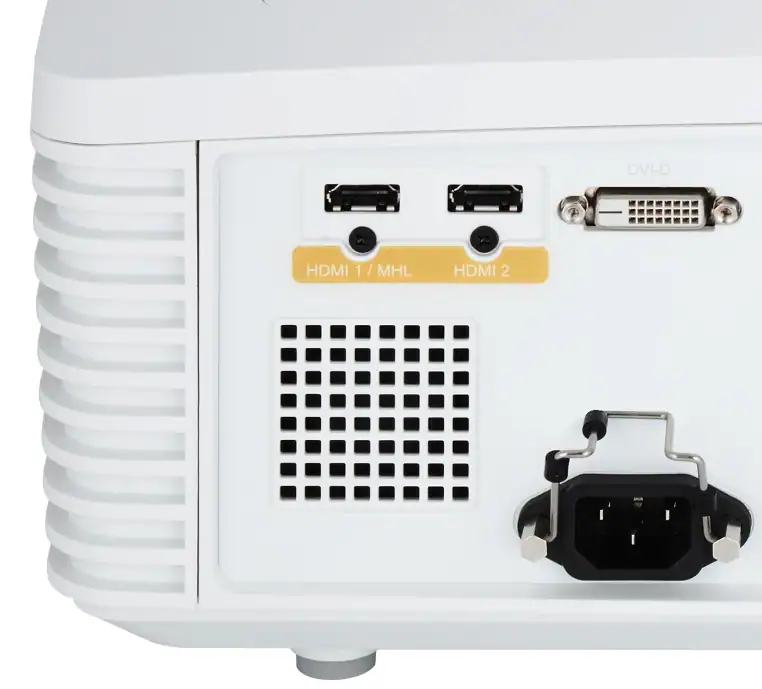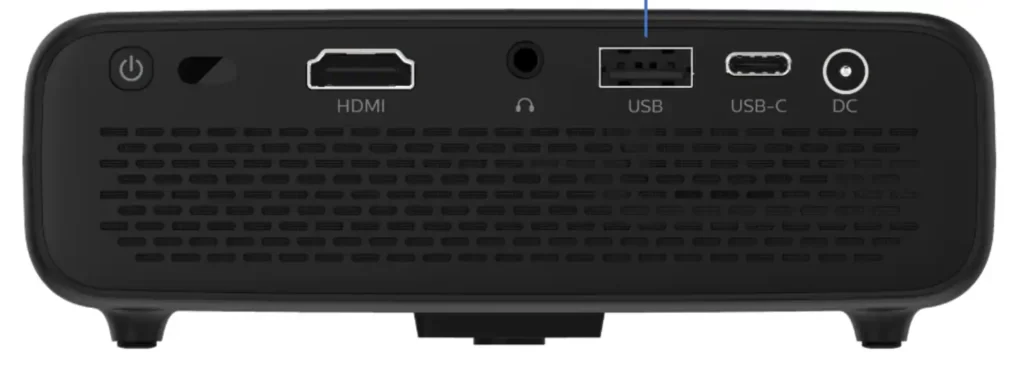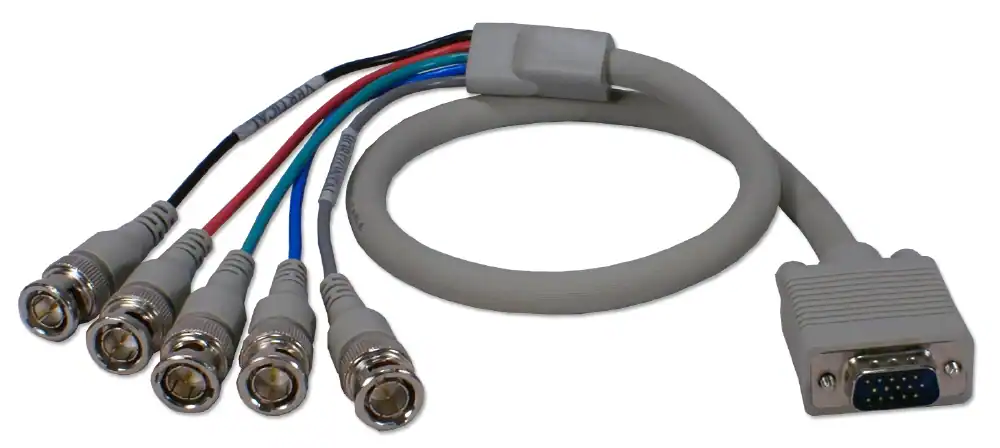Projectors are a great way to enjoy a movie or TV show on a big screen at home, but what if you wanted to project a picture onto a wall or ceiling? Or maybe you wish to have a projector with a built-in speaker so you can listen to music while you watch a movie? Projector Ports let you do just that. But what exactly are they?
Yes, The Projector ports are ports that connect your projector to other devices such as laptops, smartphones, tablets, etc. These are available in various shapes and patterns.
Want to understand much more about Projector Ports in detail? So Let’s start to explain what the various ports are used for, and which ones are most commonly used.
What are Projector Ports exactly?
With all the gadgets that we have in our life, it is necessary to know what are ports available in a projector. We have to know the projector ports because the ports are proven very helpful for connecting them with other devices.

Projectors usually have ports or physical connections that are used to connect external devices like computers, displays, speakers, microphones, and cameras to the projector. There are different types of ports. They vary in size and shape. Some are small, and some are large.
How do projector ports work?
As we know that whatever the projector ports are, all serve a similar purpose and they all can be connected to different kinds of source devices including digital cameras, game consoles, smartphones, laptops, etc.
Apart from that, most of the projectors also have USB ports that allow you to connect a flash drive and other USB-enabled devices directly. If you want to know how to use a projector port, here are some tips:

To get started, simply plug the appropriate cable into the port on the projector and the other end of the cable should be connected to your suitable device. Then, open the input settings on the projector to select the correct input. Once the connection part would be done, you would see the content on a big screen.
You May Also Like:
- What Is a Pico Projector? How to Find the Perfect Pico Projector
- How Do 3D Projectors Work? [A 3D Projector Guide]
- Different Projector Resolutions Explained: A Detailed Guide
- What is a 4K Projector? How to Find the Perfect 4K Projector?
- Projector With Coax Input
How Many Projector Ports Are There?

The projector is the most important part of a home cinema setup. It’s the main source of entertainment that will project the image onto the screen to fulfill your fun needs. It’s also the device that will deliver the sound to the speakers. So, if you want to enjoy a great movie experience, you need to make sure that your projector has the right ports.
Talking about Projector Ports, there are different types of projector ports are there in different projectors like VGA, HDMI, DVI, composite video, and S-video.

A projector port lets you connect a device that can display content on a screen. The number of projector ports can vary depending on the model and manufacturer. Each of these projectors has its own set of ports, which are listed below:
VGA port (D-Sub 15)
You can connect a projector and use it as an external monitor. This is convenient because it makes it easier for you to watch movies or play games. Most projector ports are similar to those found on VGA connectors. There are several types of projector ports that exist. One of them is the 15-pin D-Sub. This type of port is usually found on computer monitors and projectors.
For example, the VGA connector is found on most monitors and projectors, and the D-Sub 15 connector is found on projectors. The 15-pin D-Sub connector is different from the 9-pin D-Sub connector. The VGA port has only two rows of pins while the D-Sub 15 port has three rows.
Best VGA Cable? : Rankie VGA to VGA Cable
It is very important that you know what projector port you have, especially if you are planning on buying a new projector. The most common way to connect the projector is to use a VGA cable.
Composite Video (RCA)
Today, many projection systems have come equipped with composite ports. The composite video signal carries an audio component that was used to provide stereo sound. There are several different types of composite connectors, including RCA, S-Video, and Composite.

The Composite connector is used to connect several devices together. For example, a camera and a VCR could be connected together through a Composite connector, providing audio and video to the TV.
This connection works by means of a composite cable, which has two red and two green wires. This type of cable was used for many years before the development of digital technology.
The color wheel used for this connection has red, blue, and yellow stripes. The colors that are used for the video signal coming from one of these three. The RCA port uses only red and blue stripes.
Coaxial (Coax) Input

Coaxial input, also known as coax input, is another type of input found in some projectors. Coaxial cables are commonly used for transmitting TV signals and are characterized by a single copper conductor surrounded by insulation and shielding.
HDMI port
HDMI is an acronym for High-Definition Media Interface. An HDMI port is a digital connection that can be used to connect high-definition video sources such as Blu-ray players, laptops, VCRs, Digital Video Recorder (DVR), and gaming consoles to the projector. This can help you to enjoy better-quality images and sounds while watching videos. These devices may include a display screen with a resolution of 1920×1080 pixels.

Best HDMI Cable? : HDMI Cable 4K – 30ft
There are many other uses for this port as well. For instance, you may connect it to a television for enjoying home theater. You can use it to connect your projector to another device. This can help you to enjoy better-quality images and sounds while watching videos.
If you have a laptop, you can use an HDMI cable to connect it to your projector. This way, you can project images on your laptop screen and you can watch movies or play games on it. It is very easy to connect your projector to your computer.
There is no need to buy any additional cables. You can connect your computer to the HDMI port. If your computer is connected to a projector, you can project images on the screen using your computer.
Related: 4K 30hz Vs 60hz: Which HDMI Should I Pick?
USB port
Most projectors today have a built-in USB (Universal Serial Bus) port. This makes it easy to connect the projector to several devices. In fact, a lot of projectors even have a USB port for charging cell phones and other portable devices. It’s important to understand the differences between USB ports in different projectors before you buy one.

A USB port is used to connect devices such as portable music players, laptops, desktop computers, and printers. These devices are referred to as “USB-enabled” devices. This means that they are compatible with the USB port.
If you’re using a smartphone, it’s probably a Micro USB port. The port is the most important part of a projector. So, if you don’t know what the ports available in a projector are, you may not be able to get the best out of it.
DP Port aka DisplayPort
The DisplayPort is a standard connection for displaying content on a large screen. The DisplayPort is the replacement for DVI and VGA standards. It is used to connect all kinds of digital display devices.
The DisplayPort is usually located in the rear of a projector. You will find the DisplayPort on a projector, desktop monitor, laptop computer, tablet, and TV. It is also available as a separate component.
It is more than just a connector. It is also a bus, a protocol, and a set of specifications. DisplayPort cables have been developed to transmit sound, data, and video. They are easy to use and you will be able to see and hear everything clearly.
DVI
The DVI (digital visual interface) port is used to transmit digital video signals. DVI is used for high-quality image transfer from PC to a digital projector. There are various types of projectors that use DVI ports. DVI is the only port that is compatible with all types of projectors.
You can connect a computer to a projector using a DVI-D port. These ports are located on the back of the projector. The DVI-D port is a small rectangular hole that is 15 inches long. A DVI-D port is also known as a VGA port. To connect to the DVI-D port, you need a DVI-D cable. These cables vary in length and signal strength
LAN
This port allows you to connect the projector to a network for remote control, firmware updates, or streaming content from online sources.

LAN port is a term used to define a specific type of connection between a projector and a local network. The port enables the projector to be connected to the network, allowing you to use it like a computer.
A LAN port is a port that allows you to connect the projector to a local network which gives you the capability of sharing documents and media files with other users. Connecting the projector to a local network is very easy.
5BNC
This is the kind of connector that is used in many of the old televisions, radios, and projection devices. Most of the new devices use HDMI and VGA connectors. But a lot of older products still have the 5BNC connector. These are the connectors that were made a lot in the 1980s. They have been around for a long time and a lot of people still use them today. These cables are very easy to use.

If you connect two devices that have the same type of connector, then you should be able to use it. Most of the devices use this connector. It is also possible that you will be able to use it with devices that don’t use the same connector.
The 5BNC port can be used to connect a DVD player to a TV, as well as to send signals from a VCR or other device. If you have older devices with this port, you may want to see if they still work.
Frequently Asked Questions [FAQs]

Is a projector input or output?
A projector is an output device, meaning it displays content from other devices such as computers, laptops, smartphones, or gaming consoles onto a larger screen or surface. Projectors have input ports, such as HDMI, VGA, or USB ports, that allow you to connect various devices and sources to display their content on the projector screen.
However, the projector itself is not an input device and does not create content. It simply takes the input signal from another device and projects it onto a larger surface.
What ports does a projector use?
There are different types of projectors available. Some are small enough to fit into a pocket, while others are larger and are used at home or in a conference room. Many projectors use USB, VGA, Component, HDMI, or Display Port connections.
These ports are typically connected to the computer or other device that is displaying the image. Depending on which port the projector uses, the connection may be cross or backward-compatible using an adapter. For example, if the projector uses a VGA connection, it may require a VGA to HDMI adapter to display the image.
Can I use a USB port for a projector?
Yes, you can use a USB port for a projector because most modern projectors come with USB ports. They have different speeds to allow you to connect multiple devices. A USB flash drive or other USB devices can be plugged into a USB port on the projector. This allows you to play movies, music, and presentations. Moreover, there are many types of media you can use, including a USB memory stick, digital camera, camcorder, MP 3 player, and smartphone.
How Can You Use USB Ports On A Projector?
You can use USB ports on a projector to play media files directly from USB storage devices such as flash drives or external hard drives. Thus, If you have one of these devices, you can connect it to the projector using a USB cable and play media files on your screen.
To use the USB port on a projector, follow these steps:
#1. Insert the USB storage device into the USB port on the projector.
#2. Turn on the projector and select the input source to USB.
#3. Navigate to the media files on the USB device using the projector’s remote control or on-screen menu.
#4. Select the media file you want to play and press the play button.
#5. The media file will be displayed on the projector screen.
What is the port of projector in laptop?
HDMI ports can be found in various models of laptops. These ports can be used for many purposes. Some people use them to connect their laptops to a projector. If you want to connect a laptop and showcase your content to a big screen, you can also use it to connect to a projector. There is no need for a converter box or a separate cable. You can use an HDMI cable to connect your projector to your laptop.
Summary
As you’ve covered the topic “Projector Ports”, we hope that now you understood completely the common ports that are available in the projector. One important tip is that It is good to use the same connector on your projector that is used on other devices. Although, some projectors come with a built-in connector that is suitable for connecting them to various devices such as computers.
In summary, there are three different ways that you can connect your projector to devices (wired method). You can use HDMI cables, VGA cables, or DVI cables. The one that you select will depend on the type of device that you intend to connect to your projector.
The most common types of ports available on a projector are USB and HDMI. These two types of ports are the most popular for connecting your projector to other devices. You can connect your projector to a computer, smartphone, tablet, or even a DVD player using one of these ports. Thank You For Reading!
As an experienced Software Engineer in a Projection-Based Technology Company, I love sharing my Knowledge to utilize and help others to learn more about Projectors. Thus one can get the right Projector for their needs.



